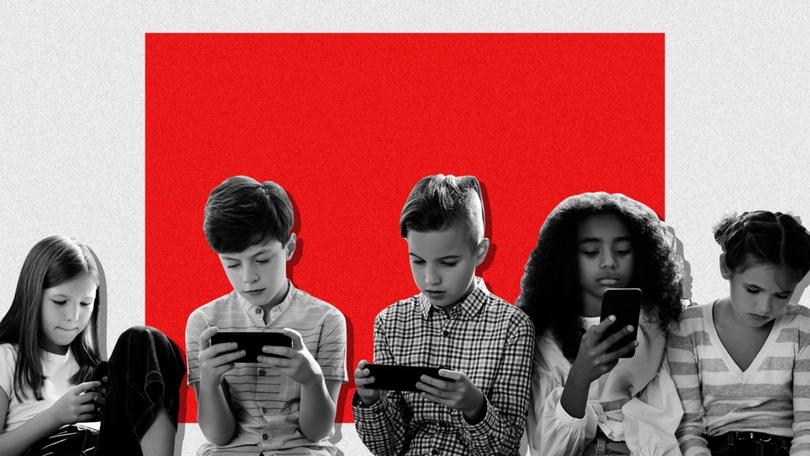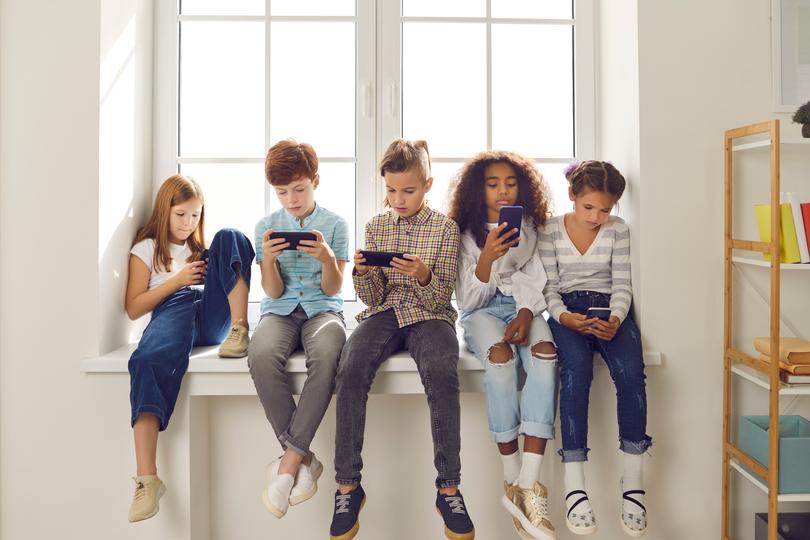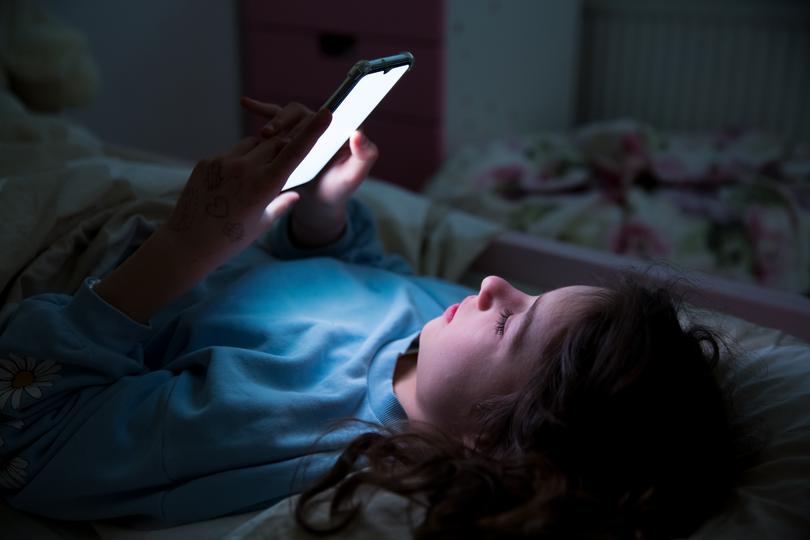How smartphones and social media have ‘deformed’ childhood and created a generation of dysfunctional adults

A leading social psychologist says we need to make a “dramatic cultural correction” and get kids off devices because the new “phone-based childhood” is making young people sick and preventing them from becoming fully functioning adults.
Author and social psychologist Jonathan Haidt claims that the “intrusion of smartphones and social media” has deformed childhood and caused a marked decline in play, independence and risk-taking.
Sign up to The Nightly's newsletters.
Get the first look at the digital newspaper, curated daily stories and breaking headlines delivered to your inbox.
By continuing you agree to our Terms and Privacy Policy.And that the environment in which adolescents grow up today is “hostile to human development” because they spend up to nine hours a day on devices and use social media “almost constantly”, at the cost of almost everything else in their lives.
In an 8000-word article in The Atlantic, Dr Haidt detailed how for many young people, “nearly every waking hour is an hour absorbed, in full or in part, by their devices”.
“Everything else in an adolescent’s day must get squeezed down or eliminated entirely to make room for the vast amount of content that is consumed, and for the hundreds of ‘friends’, ‘followers’, and other network connections that must be serviced with texts, posts, comments, likes, snaps, and direct messages,” he wrote this month.
In his new book, The Anxious Generation: How the Great Rewiring of Childhood Is Causing an Epidemic of Mental Illness, the renowned American psychologist meticulously traced what he believes “went suddenly and horribly wrong” for adolescents in the early 2010s after the introduction of smartphones and social media platforms.
While the internet came into our lives in the mid-1990s, Dr Haidt said it was not until the introduction of the iPhone and high-speed internet in 2007, that it became possible for adolescents to spend “nearly every waking moment online”.
After the iPad’s release in 2010, it “quickly became a staple of young children’s daily lives”.
“It was in this brief period, from 2010 to 2015, that childhood …. was rewired into a form that was more sedentary, solitary, virtual, and incompatible with healthy human development,” he wrote in The Atlantic.
Since the early 2010s, sleep, exercise and book reading have declined while the rate of depression, anxiety and suicide has dramatically increased around the world, including in Australia.
“By a variety of measures and in a variety of countries, the members of Generation Z (born in and after 1996) are suffering from anxiety, depression, self-harm, and related disorders at levels higher than any other generation for which we have data,” he wrote.
“The decline in mental health is just one of many signs that something went awry.”
The OECD’s Programme for International Student Assessment has also recorded declines in math, reading, and science skills globally since the early 2010s.
Dr Haidt said Generation Z, sometimes referred to as ‘zoomers’, are exhibiting problems well into adulthood.
“And if a generation is doing poorly — if it is more anxious and depressed and is starting families, careers, and important companies at a substantially lower rate than previous generations — then the sociological and economic consequences will be profound for the entire society,” he wrote.

Dr Haidt, who has long studied social and moral development, believes that since around 2010 digital technology has altered adolescent development and led to gigantic increases in mental illness. And he is seeing similar trends worldwide.
“Those were the years when adolescents in rich countries traded in their flip phones for smartphones and moved much more of their social lives online – particularly onto social-media platforms designed for virality and addiction,” he wrote.
“Once young people began carrying the entire internet in their pockets, available to them day and night, it altered their daily experiences and developmental pathways across the board.
“Friendship, dating, sexuality, exercise, sleep, academics, politics, family dynamics, identity — all were affected.
“Life changed rapidly for younger children, too, as they began to get access to their parents’ smartphones and, later, got their own iPads, laptops, and even smartphones during elementary school.”
Dr Haidt said smartphone and social media use are responsible for “so many harms” to adolescents, in addition to the impact on mental health.

They have also caused fragmented attention, disrupted learning, addiction, social withdrawal, the decay of wisdom and the loss of meaning.
“Social-media companies such as Meta, TikTok, and Snap are often compared to tobacco companies, but that’s not really fair to the tobacco industry,” he said.
“It’s true that companies in both industries marketed harmful products to children and tweaked their products for maximum customer retention (that is, addiction), but there’s a big difference: Teens could and did choose, in large numbers, not to smoke.
“Cigarettes trapped individual smokers with a biological addiction. Social media has trapped an entire generation in a collective-action problem.”
The author says the “smartphone-based life” interferes with a great number of developmental processes.
“My claim is that the new phone-based childhood that took shape roughly 12 years ago is making young people sick and blocking their progress to flourishing in adulthood,” he said.
“We need a dramatic cultural correction, and we need it now.
“We didn’t know what we were doing in the early 2010s. Now we do. It’s time to end the phone-based childhood.”
His advice to overwhelmed and harried parents involves introducing “four norms” that cost nothing.
The first rule is not to let kids have smartphones before they start high school.
“Delaying round-the-clock internet access until ninth grade (around age 14) as a national or community norm would help to protect adolescents during the very vulnerable first few years of puberty,” he said.
The second rule is banning social media before the age of 16.
“The trap here, as with smartphones, is that each adolescent feels a strong need to open accounts on TikTok, Instagram, Snapchat, and other platforms primarily because that’s where most of their peers are posting and gossiping,” he said.
“The delay would not mean that kids younger than 16 could never watch videos on TikTok or YouTube – only that they could not open accounts, give away their data, post their own content, and let algorithms get to know them and their preferences.”
Thirdly, he wants schools to be truly phone-free.
“Schools that have gone phone-free always seem to report that it has improved the culture, making students more attentive in class and more interactive with one another,” he said. Studies support this.
Finally, he wants parents to encourage more independence, free play and responsibility “in the real world”.
“If parents don’t replace screen time with real-world experiences involving friends and independent activity, then banning devices will feel like deprivation, not the opening up of a world of opportunities,” he said.
Dr Haidt said he is confident that the “epidemic of adolescent mental illness” was kicked off by the arrival of the phone-based childhood because no other events can explain “both the timing and international scope of the disaster”.
“The main reason why the phone-based childhood is so harmful is because it pushes aside everything else. Smartphones are experience blockers,” he said.
“Our ultimate goal should not be to remove screens entirely, nor should it be to return childhood to exactly the way it was in 1960.
“Rather, it should be to create a version of childhood and adolescence that keeps young people anchored in the real world while flourishing in the digital age.”

